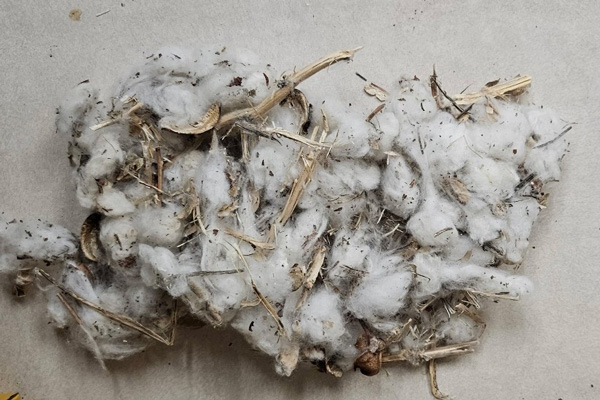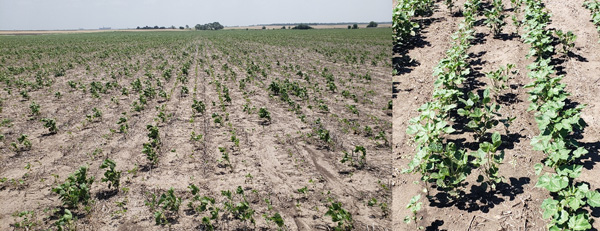Volunteer plants of one crop growing in another can be considered weeds because they can reduce the yield, quality, and harvest efficiency of the current crop (Figure 1). In the cotton-producing regions of Kansas, cotton frequently follows soybeans in no-till or reduced-till cropping systems. In the past, the best way to control volunteer plants in this situation would be to rotate herbicide-resistance traits from year to year. The inability to use dicamba-containing herbicides over the top of cotton or soybeans in 2025 exacerbates the challenge of controlling volunteer soybeans in cotton fields (Figure 2), or the less common scenario of volunteer cotton in soybean fields.

Figure 1. Plant material in harvested cotton with volunteer soybeans can severely impede the ginning process and penalize loan values. Photo courtesy of Rex Friesen, Southern Kansas Cotton Growers.

Figure 2. Volunteer soybean in seedling cotton. Photo courtesy of Rex Friesen, Southern Kansas Cotton Growers.
Volunteer soybean in cotton
If Enlist cotton is planted, Enlist One or Enlist Duo will control volunteer soybeans, as long as it is not Enlist soybeans. However, there are very few options to control Enlist soybeans in Enlist cotton. Research from North Carolina suggests trifloxysulfuron (Envoke) effectively controls volunteer soybeans. However, STS soybeans must be planted in the following spring.
Volunteer cotton in soybean
Like the previous scenario, volunteer cotton can be controlled in Enlist Soybeans with Enlist One or Enlist Duo, as long as it is not Enlist cotton. Preemergence application of S-metolachlor + metribuzin (Boundary) will reduce volunteer cotton emergence. Controlling volunteer Enlist cotton in Enlist soybeans can be accomplished by postemergence applications of fluthiacet (Cadet) pyraflufen (Vida, others),
Other management options
If an applicator is willing to utilize hooded or post-directed application equipment, the following contact herbicides can be used to control either volunteer cotton or soybeans, no matter which of the currently available herbicide-resistance traits are present. Contact herbicides include: carfentrazone (Aim, others), linuron (Lorox, others), or paraquat (Gramoxone, others). In addition, hooded applications of flumioxazin (Valor, others) may be used in cotton.
If volunteers are a significant concern due to harvest conditions in the previous year, the best alternative may be to rotate to corn or grain sorghum, which would allow for more herbicide options for broadleaf control.
More information about weed management in soybean and cotton can be found in the “2025 Chemical Weed Control for Field Crops, Pastures, and Noncropland” guide at https://www.bookstore.ksre.ksu.edu/pubs/CHEMWEEDGUIDE.pdf or check with your local K-State Research and Extension office for a paper copy.
The use of trade names is for clarity to readers and does not imply endorsement of a particular product, nor does exclusion imply non-approval. Always consult the herbicide label for the most current use requirements.
Sarah Lancaster, Extension Weed Science Specialist
slancaster@ksu.edu
Logan Simon, Southwest Area Agronomist, Garden City
lsimon@ksu.edu
Tags: soybeans weed control cotton volunteer